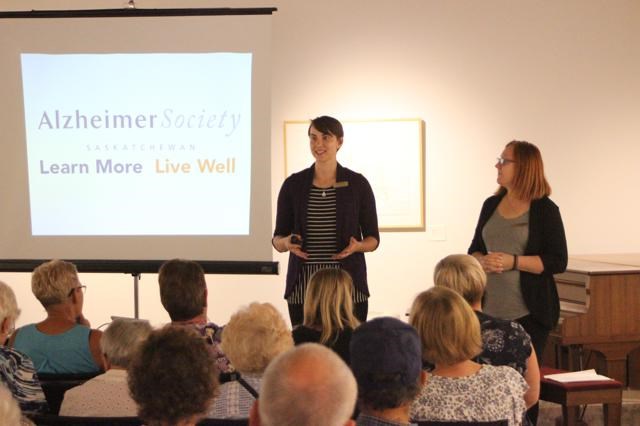A capacity audience packed the Allie Griffin auditorium at the Weyburn Public Library on Wednesday to hear a presentation about dementia from representatives of the Alzheimer Society of Saskatchewan.
Abby Wolfe, the public awareness coordinator for the Alzheimer Society, along with a colleague, Jennifer Froese, a First Link Coordinator at the Resource Centre located in Estevan, talked about the ABCs of dementia, and how people might be able to recognize the warning signs of dementia in loved ones and friends.
Wolfe noted that the words “dementia” and Alzheimer’s are not interchangeable, as Alzheimer’s disease is only one form of dementia, and there are many others that can affect a person that do not involve Alzheimer’s.
For example, there is vascular dementia, which affects the brain in a very different way than Alzheimer’s, and can be common after a stroke where an area of the brain is deprived of blood for a time, causing damage.
There is also mixed dementia, where a person might have multiple types of dementia at the same time, or frontal lobe dementia.
“Diagnosis can be quite complicated, because of the ways the brain can be affected,” said Wolfe, who pointed out that one common misconception is that dementia only afflicts the old.
“Dementia is not a normal part of aging,” she said, noting dementia is a neuro-degenerative condition that affect anyone of any age, as there are people in their 40s and 50s who have forms of dementia.
“It should not be assumed that every older person will have dementia. There are things like untreated infections, like urinary infections or vitamin deficiencies, which can cause dementia-like symptoms, but are treatable,” said Wolfe.
Alzheimer’s disease affects the physical structure of the brain, as it produces more spaces in the brain and the mass of the brain is reduced. “You can’t see these changes occurring, and you can’t tell someone has dementia simply by looking at them,” she added.
Some of the risk factors of dementia include age, although not every person who has dementia is older. For those who are over 65, the chances of getting dementia double every five years.
Other factors include acquired brain injury (which can occur at any age), one’s gender, and other medical conditions such as diabetes.
Some types of dementia are genetic, like familial Alzheimer’s, which comprise about five to seven per cent of dementia cases, but the vast majority of dementia cases are not genetic.
Wolfe pointed out that physical and social activity are important for those who are older, and contribute towards good brain health. She also noted that anything that is good for heart health is also good for brain health.
Currently over 19,000 Saskatchewan residents live with diagnosed dementia, and it is estimated that by 2038, there will be more than 28,000 residents with dementia.
Wolfe noted there is no one test to diagnose someone with dementia, but a person needs to be tested by a doctor, with certain treatable conditions to be ruled out first (such as untreated infections), and a person may need to be referred to a specialist.
Warning signs of dementia may include a person changing their day-to-day routines, such as forgetting how to do a task they have done for many years, or having difficulty doing such tasks or remembering things like where they live.
Wolfe pointed out that forgetting things aren’t necessarily a sign of dementia, as everyone has moments where they forget things, but with the onset of dementia, they are having trouble with tasks or activities that they have been doing for most of their lives.
Other warning signs include misplacing things or putting them in inappropriate places, and not knowing what day or year it is, or what season it is. There may also be changes in personality, in a person’s general mood or in their judgment (such as poor judgment in decision-making or in spending money), or major mood changes for no apparent reason, uncharacteristic confusion, suspicion or paranoia.
A person could also have a complete loss of initiative where they are unusually withdrawn or passive in regard to hobbies or activities they have always taken part in before.
“We want to encourage people to learn more,” said Wolfe. “If you recognize these signs in yourself or in others, you can go to a doctor to talk about it.”
She pointed out that the Alzheimer Society does not conduct these kinds of tests, but they do provide support and information to a person and their family after a diagnosis has been given.
An audience member pointed out that when she approached a person she knows who has exhibited some of the warning signs, she was met with anger and hostility, and asked how one could deal with that situation.
“Anger is always a response to something, whether it’s external or internal factors. Understanding those is something better done in an individual’s situation,” answered Wolfe.
She suggested one approach could be to say they have noticed some things and are concerned, or to ask when they were last seen by a doctor.
“It’s a challenging conversation to address,” said Wolfe. “You can say that you want to support this person and understand what’s happening.”
The Alzheimer Society has a toll-free dementia help line, where support staff will provide information, support and connections to programs and services. The number is 1-877-949-4141, and is open Monday to Friday from 8:30 a.m. to 4:30 p.m.



